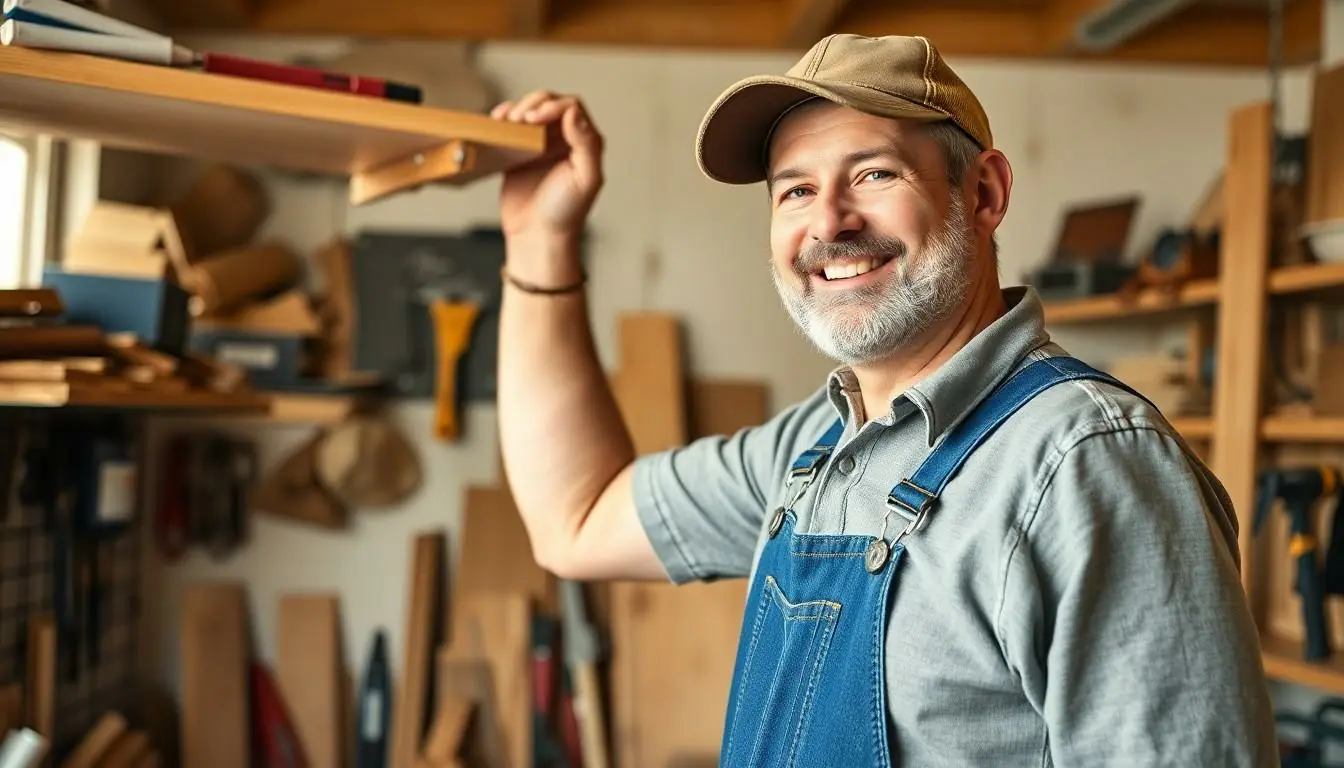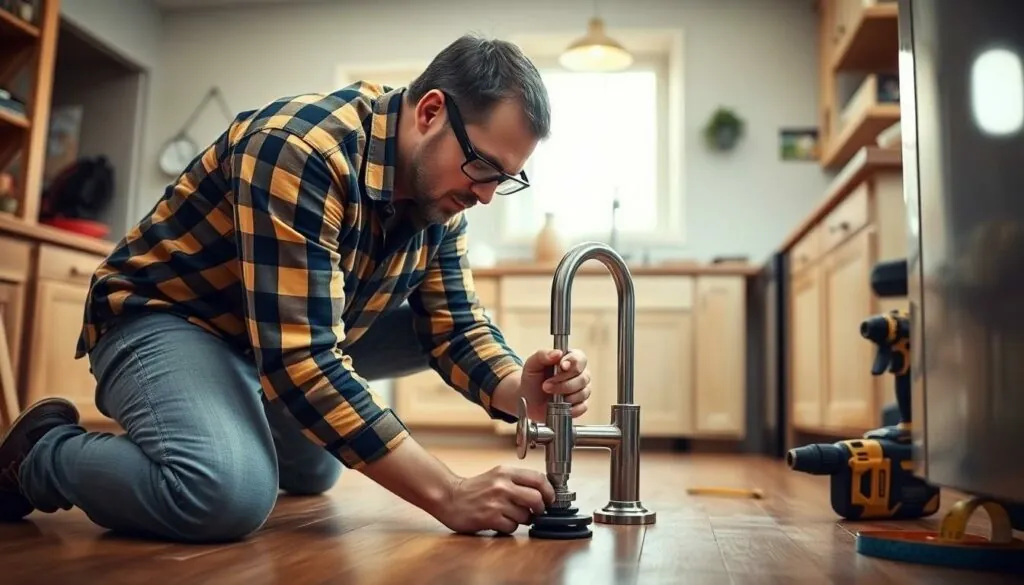Table of Contents
ToggleHome repairs can feel like a daunting task, but they don’t have to be. Imagine tackling that leaky faucet or creaky door with the confidence of a seasoned pro. DIY home repair isn’t just about fixing what’s broken; it’s about discovering the hidden handyman within. With a few tools and a sprinkle of determination, anyone can transform their home into a masterpiece of functionality.
What Is DIY Home Repair?
DIY home repair involves undertaking maintenance and repair tasks without hiring professionals. This practice includes projects like fixing dripping faucets, patching drywall, or repairing squeaky floors. Homeowners can successfully execute these tasks with the right tools and a bit of research.
Many resources such as online tutorials and instructional videos provide guidance. These contributions allow individuals to learn essential skills needed for home repairs. Engaging in DIY work promotes confidence, as accomplishing a repair often leads to a sense of achievement.
Embracing DIY home repair can also lead to cost savings. Homeowners save money on labor costs while gaining the satisfaction of improving their living space. Each project offers an opportunity to personalize a home and tackle specific needs or aesthetics.
Essential tools for DIY repairs usually include a hammer, drill, tape measure, and screwdriver set. These items form a basic toolkit effective in handling various household tasks. As confidence grows, individuals might explore more complex projects involving electrical or plumbing systems.
Understanding one’s limitations is crucial in DIY home repair. While some projects can be tackled confidently, others may require professional intervention to ensure safety and compliance with local regulations. By recognizing when to seek help, individuals can maintain a balance between self-sufficiency and professionalism.
DIY home repair not only enhances functionality but also encourages creativity. Individuals can make unique choices that reflect personal style throughout their homes. Each step taken, no matter how small, contributes to a deeper connection with one’s living space.
Benefits of DIY Home Repair

Engaging in DIY home repair offers numerous advantages for homeowners. Two key benefits include cost savings and skill development.
Cost Savings
Cost savings represent one of the most significant benefits of DIY home repair. Homeowners save money by eliminating labor costs associated with hiring professionals. For instance, fixing a leaky faucet can save upwards of $150 compared to professional services. Materials often become the only expense when tackling these tasks, and many online resources provide DIYers access to affordable supplies. Some projects may even provide long-term savings by increasing the home’s value and reducing future maintenance costs. Overall, undertaking repairs independently cultivates a budget-friendly approach to home maintenance.
Skill Development
Skill development occurs naturally through DIY home repair activities. Homeowners gain practical experience as they implement various tasks, from patching drywall to installing shelves. Every completed project enhances confidence and fosters new skills. Videos and tutorials offer guided instructions, allowing individuals to learn at their own pace and experiment with different techniques. Many also discover a newfound passion for home improvement, often seeking out more complex projects over time. As skills develop, homeowners not only improve their properties but also invest in their personal growth through hands-on learning experiences.
Common DIY Home Repair Projects
Homeowners can tackle various DIY projects to enhance their living spaces. Each task contributes to improved functionality and comfort.
Plumbing Repairs
Plumbing repairs rank among the most common DIY tasks. Fixing a leaky faucet proves straightforward and often involves replacing washers or O-rings. Clogs can be cleared using a plunger or drain snake, making this a manageable project. A running toilet typically needs new flapper valves, which are affordable and easy to install. Engaging in plumbing repairs saves homeowners considerable money, turning potential expenses into self-made solutions.
Electrical Fixes
Electrical fixes represent another area where homeowners can take initiative. Replacing cracked outlet covers or light switch plates requires minimal tools and expertise. Installing a ceiling fan or replacing light fixtures enhances room aesthetics and can improve energy efficiency. Homeowners must ensure the circuit is off before proceeding with any electrical work to ensure safety. Resources like online tutorials simplify many projects, making them accessible and manageable.
Drywall and Painting
Repairing drywall and painting can dramatically refresh a room’s appearance. Patching small holes using spackling paste is a quick task that enhances aesthetics. For larger repairs, homeowners can cut and replace drywall panels. Painting walls offers a chance for creativity; choosing the right color transforms spaces. Adopting techniques like tape application can yield crisp lines and professional-looking finishes, ensuring satisfaction with the completed project.
Tools and Materials Needed
Having the right tools and materials simplifies DIY home repairs and boosts confidence. The following categories provide essential items for most projects.
Essential Tools
Basic hand tools play a crucial role in tackling home repair tasks. A hammer offers utility for driving nails into various surfaces. Screwdrivers come in different sizes and types, serving diverse fastening needs. A tape measure ensures precise measurements for accurate cuts and placements. Additionally, a drill enables easy installation of fixtures and repairs with versatile bits. A level verifies that installations remain straight and aligned. Safety gear, including gloves and goggles, protects against potential hazards during repairs. Investing in a toolkit that includes these items prepares homeowners for a range of projects.
Recommended Materials
Specific materials often enhance the effectiveness of DIY repairs. Caulk fills gaps to prevent air leaks and moisture intrusion, ensuring better insulation and protection. Wood glue provides strong bonds for wooden items or repairs, strengthening structural integrity. Patching compound effectively addresses minor wall damage before painting, enabling a smooth finish. For plumbing and electrical projects, appropriate fittings and connectors ensure safe and functional results. Paint in various finishes allows homeowners to refresh and personalize their spaces. Stocking these materials contributes to efficient project completion and enhances the overall outcome.
Safety Tips for DIY Home Repair
Prioritizing safety during DIY home repair projects is essential. Always wear appropriate safety gear, including gloves, goggles, and masks, to protect from potential hazards. Understanding the tools and materials before starting a project prevents accidents.
Ensure workspaces are well-lit and organized, minimizing tripping hazards and improving focus. Use sturdy ladders or stools for reaching high places and maintain three points of contact for stability.
When tackling electrical projects, turn off the power supply at the circuit breaker, preventing shocks. Always double-check code compliance for specific tasks, as local regulations vary.
Keep a first aid kit nearby and familiarize everyone involved with its contents. Accidents can happen, so being prepared is crucial.
Consider working with a partner for larger projects, ensuring support and assistance when needed. Often, one person can hold materials while the other operates tools, enhancing safety and efficiency.
If unsure about a task, seeking professional help can be wise. Some repairs, especially plumbing or electrical, might lead to bigger issues if done improperly.
Staying informed through online tutorials can also promote safe practices. Many reputable sources provide safety guidelines tailored to specific DIY projects.
Lastly, perform regular tool maintenance to ensure equipment functions safely and effectively. Clean tools after use and store them properly to prolong lifespan and consistency.
Embracing DIY home repair can transform how homeowners view their living spaces. By taking on simple tasks they can save money while building valuable skills. Each repair completed not only enhances the home’s functionality but also fosters a sense of accomplishment.
With the right tools and resources at hand anyone can tackle projects ranging from plumbing fixes to painting. Safety should always be a priority and knowing when to seek professional help is essential.
Ultimately engaging in DIY projects allows individuals to express their creativity and make their homes truly their own. The journey of home improvement is rewarding and offers endless opportunities for personal growth and satisfaction.





